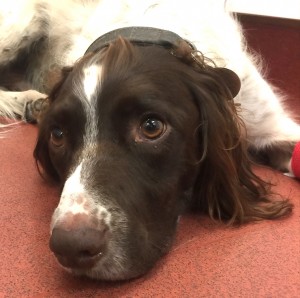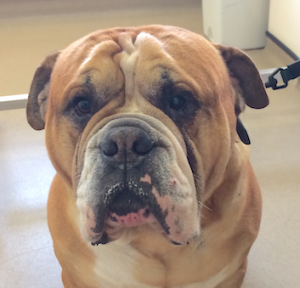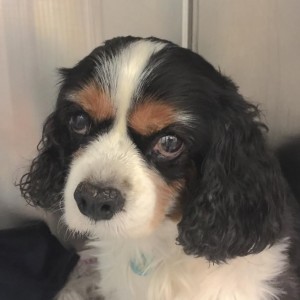News
Archive for the ‘Pet of the Month’ Category
Pet of the month – February – Ruby
by admin on February 1st, 2018
Category: Pet of the Month, Tags:
Tracheal collapse is a progressive weakening of the tracheal cartilage, or “windpipe”, seen most commonly in middle-aged small breed dogs. As the trachea collapses it results in an obstruction to the passage of air. Certain breeds including Yorkshire Terriers, Bichon Frise and Pomeranians are more prone to this condition
How can I tell if my dog has tracheal collapse?
Tracheal collapse is characterised by a harsh “goose honking “cough that is often worsened by excitement. The disease is often worse in the summer months due to the heat. While the disease typically progresses over months or years, some dogs can present with a sudden onset difficulty breathing and require emergency therapy. Dogs with tracheal collapse can often have other conditions including heart murmurs, pneumonia or problems with their larynx/palate.
How is tracheal collapse diagnosed?
Tracheal collapse is a dynamic process meaning that it can often be missed on normal chest radiograph (x-ray). Ideally, it is diagnosed using a combination of fluoroscopy – a video x-ray that allows visualisation of the trachea as the dog inhales and exhales – and bronchoscopy, where a camera is passed down the trachea to assess the degree of collapse and assess for other conditions, such as pneumonia.
How is tracheal collapse treated?
Medical management
The vast majority of dogs will respond to lifestyle changes (weight loss, being walked with a harness rather than a neck lead, avoidance of cigarette smoke or aerosols in the house) in combination with medications (corticosteroids, cough suppressants and antibiotics). Almost all dogs will have some improvement with the introduction of medication and up to 90% will be well controlled for 12-18 months.
Tracheal stenting
Tracheal stenting involves placing a metal (nitinol) mesh within the trachea under anaesthesia. The stent holds the trachea open and stops the airway obstruction. 90% of cases show a rapid improvement in clinical signs. It is important to know that dogs that have a tracheal stent placed will likely still require lifelong medications as outlined above.
What are the potential complications with tracheal stenting?
Tracheal stenting should only be performed by veterinary surgeons who have been properly trained in the technique. As the procedure requires fluoroscopy it is normally only performed at a referral practice. Many of the complications associated with stenting such as stent movement or fracture are more likely to occur if an incorrect size of stent has been placed. However, even when performed by appropriately trained personnel the complications seen with the technique can include inflammatory tissue growing through the stent and chronic infections. Up to 40% of cases that have a tracheal stent placed may require a second procedure at some point in their life. Following stent placement, most animals will be discharged within 24-28 hours.
Pet of the month – January – Max
by admin on December 6th, 2017
Category: Pet of the Month, Tags:
Understandably Max went off his food and became listless. A swelling became palpable below his jaw and on examination, bruising was discovered under the tongue. The injury became septic and was flushed under anesthetic. Max is now doing very well and has finished all his antibiotics.
Although we cannot be sure how Max sustained this injury, a number of dogs love to carry a stick and some will actively find their own stick when exercising off the lead on a walk. The majority of the time, this is harmless fun but sometimes part of a stick can go further into the mouth than planned! Stick injuries in dogs can be serious.
Occasionally, a section of twig can get lodged across the hard palate (this is the roof of the mouth), between the upper molar teeth. If a dog has run at speed to pick up a stick then he/she may in effect ‘run onto the stick’, and there is potential for sections of stick or twig to penetrate deeper into the mouth, neck or throat.
Although not applicable in Max’ situation, a good tactic to try and avoid your pets chasing and carrying sticks is to provide other toys for them to play with whilst on their walks, and definitely, as pet owners, we should avoid the temptation to actually throw a stick for our dogs!
Pet of the month – December – Zebedee
by admin on December 2nd, 2017
Category: Pet of the Month, Tags:
Pet of the month for December is Zebedee, who was brought in to us a few weeks ago as an emergency following a car accident.
Zebedee’s jaw was fractured along the line of the mandibular symphysis. This is a fibrocartilaginous joint that is the most common site of mandibular fractures in feline patients and always needs to be repaired. The repair was relatively uncomplicated but the swelling and trauma to his jaw meant that Zebedee would not be able to eat or drink normally for several weeks. To enable him to receive adequate nourishment an oesophageal feeding tube was placed and he was tube fed until he was able to eat and drink again normally.
To further his woes Zebedee was not microchipped and an owner did not come forward, so we decided to take him on as a practice cat and are delighted that he has just this week been found a good home.
Pet of the month – November – Fred
by admin on November 1st, 2017
Category: Pet of the Month, Tags:
Hyperthyroidism is a relatively common disease of the aging cat. It is typically the result of a benign (non-cancerous) increase in the number of cells in one or both of the thyroid glands. The thyroid glands are located in the neck although there is occasionally additional tissue within the chest. In the image, the red shapes indicate approximately where the thyroid glands are located in a cat. The result of enlargement of the thyroid glands is an increased production of thyroid hormone within the body. Thyroid hormone controls the rate at which cells in the bodywork; if there is too much hormone, the cells work too fast. Despite many years of research, the exact cause of hyperthyroidism remains unknown.
Cats fed almost entirely canned food have been reported to have an increased risk of developing hyperthyroidism but it is likely that there are many causes.
What signs do cats with hyperthyroidism get?
Hyperthyroidism is a disease of middle-aged to older cats with an average age of onset of 12-13 years. Increased drinking and increased urination, weight loss, increased activity, vomiting, diarrhoea and increased appetite are often reported. Physical examination often reveals a small lump in the neck which represents an enlarged thyroid gland.
How is hyperthyroidism diagnosed?
A diagnosis of hyperthyroidism is made by the demonstration of increased levels of thyroid hormone in the bloodstream. Thyroxine (T4) measurement is the initial diagnostic test of choice.
How is hyperthyroidism in cats managed?
Medical treatment with either carbimazole or methimazole. These tablet medications are given once or twice daily lifelong. Side effects are uncommon but can occur. They include vomiting and reduced appetite. Very occasionally severe bone marrow or liver problems can be seen.
Dietary treatment. A specific prescription diet can be fed to hyperthyroid cats to control the disease. The diet is very low in iodine. Iodine is an essential component of thyroid hormone and less dietary iodine means less thyroid hormone is produced. The diet must be fed exclusively (i.e. the cat must eat no other food). Dietary treatment does not lower the thyroid hormone levels as much as the other treatment options
Surgical treatment. One or preferably both thyroid glands are removed with an operation. A short period of treatment with tablets is recommended prior to surgery. Anaesthesia can be a risk in older cats with hyperthyroidism that possibly has other concurrent diseases. There is a risk of a low blood calcium level after surgery if the parathyroid glands are removed with the thyroid glands. This can be a very serious problem if it is not recognised. Signs of a low blood calcium level can include facial rubbing, fits, tiredness, reduced appetite, and wobbliness. Low blood calcium levels are relatively easily managed with oral medication and treatment is rarely necessary lifelong.
Radioactive iodine treatment. Radioactive iodine is concentrated in the thyroid gland and destroys excessive thyroid tissue. The drug is given by injection under the skin. After the injection, cats need to spend 2-4 weeks in an isolation facility whilst they eliminate the radioactive material. Owners are not able to visit their pets whilst they are in isolation.
Hyperthyroidism can mask underlying kidney problems and these can become apparent after treatment. Blood tests are therefore necessary to assess kidney function as well as the thyroxine level during treatment.
Pet of the month – October – Sophie
by admin on October 3rd, 2017
Category: Pet of the Month, Tags:
Sophie is recovering extremely well following the removal of a stick from her stomach using our new fibreoptic endoscope.
An endoscope is a long, thin, flexible tube that has a light source and camera at one end. Images of the inside of your body are relayed to a television screen.
Endoscopes can be inserted into the body through a natural opening, such as the mouth and down the throat, or through the bottom. An endoscope can also be inserted through a small cut (incision) made in the skin when keyhole surgery is being carried out.
Our three endoscopes range from one that is small enough to examine the nasal cavity to larger diameter ones for exploring the airways and gastrointestinal tract. It is amazing to be able to explore deep within the body yet with minimal trauma to the patient, and in this instance without the need for a surgical laparotomy to remove the stick. For Sophie this meant instant resolution.
Pet of the Month – September 2017 – Lola
by admin on September 2nd, 2017
Category: Pet of the Month, Tags:
We are delighted to report that Border Terrier Lola is recovering well from a procedure called gastrotomy in which an incision is made into the stomach under general anaesthesia.
Lola became unwell recently, quite out of the blue, and was in obvious abdominal pain. Medication was of little assistance so further investigation was undertaken. When a round opaque object was seen on radiographs of her abdomen an exploratory laparotomy was performed. A stone was located in and removed from her stomach.
Lola was a pleasure to look after and is now back to her former self as you can see in this picture.
Pet of the Month – August 2017 – Harry
by admin on August 1st, 2017
Category: Pet of the Month, Tags:
Pet of the Month this August is Harry, a handsome 7 year old German Shepherd Dog. We are delighted to report that he has recovered extremely well following recent surgery for Gastric Dilatation.
What is gastric-dilatation and volvulus (GDV)? Is my dog at risk?
Gastric dilatation and volvulus, or GDV as it is commonly abbreviated, is a relatively common clinical syndrome seen in large / giant breeds of dog. Dilatation refers to bloating of the stomach with gas, and volvulus refers to twisting of the stomach about its axis. The cause of this syndrome is not completely understood. In fact it is quite controversial which occurs first; the bloat or the volvulus (twisting). Indeed both components do not have to occur together and some patients will develop relatively simple bloat alone. GDV is a potentially life threatening condition and emergency veterinary attention should be sought immediately if it is suspected.
Why is GDV potentially life-threatening to dogs?
There are a number of serious and potentially fatal consequences that occur as a result of GDV. Initially the severe distension of the stomach stretches the blood vessels over its surface reducing the blood supply to the stomach walls. This is made worse by the twisting of the stomach which also twists the blood vessels, effectively shutting off blood supply to the stomach. A lack of blood flow means there is a lack of oxygen and nutrients delivered to the stomach and waste products are not removed. As with any organ this will result in parts of it dying. This process happens very quickly and in severe cases could result in part of the stomach wall rupturing and releasing its contents into the abdomen.
The large distended stomach occupies much more space inside the abdominal cavity and compresses surrounding structures. Severe distension puts pressure on the diaphragm and interferes with the patient’s ability to breath. It also applies pressure to a large blood vessel in the abdomen (the vena cava) that normally returns blood from the back half of the body to the heart. Pressure on this vessel obstructs flow therefore reducing the amount of blood returned. If blood can’t be returned to the heart, then it in turn can’t pump it out to the rest of the body. If there is insufficient blood being pumped, the blood pressure falls dramatically making the patient weak and potentially leading to collapse.
To add insult to injury, other organs in the body such as the lungs, kidneys, liver and intestines do not receive a blood supply and begin to fail. The lack of a functional circulation also means that toxic products build up in these organs that further compromise the patient. These changes can happen in a matter of hours, emphasizing the importance of early veterinary attention.
What are the symptoms of GDV in dogs?
The symptoms generally include obvious distension or enlargement of the abdomen with unproductive vomiting or retching. The patient may drool excessively and appear restless or agitated. As the condition progresses the patient may become increasingly weak or even develop shock and collapse.
What is the treatment for GDV?
The age and breed of the patient coupled with the clinical signs of a severely bloated abdomen will make your vet highly suspicious of this condition. They will immediately place one or more an intra-venous catheters to allow administration of fluids to support the circulation and dilute toxins in the blood. They may also analyse the patient’s blood to assess the severity of organ damage.
The next stage involves attempts to decompress the stomach. This is usually accomplished by passage of a specially designed tube through the mouth down into the stomach. There is a gag that can be used to assist in this process but many patients will require sedation or anaesthesia to complete the task. It can be very challenging or sometimes impossible to perform stomach tubing. This is particularly the case when the stomach is twisted 360 degrees or more. In this instance a cannula (tube) may have to be inserted through the body wall and into the stomach to allow deflation. Deflation is clearly an imperative step because it will relieve pressure on the diaphragm and help restore blood flow back to the heart through the vena cava.
Radiographs of the abdomen are often required to help distinguish between simple dilatation and dilatation with volvulus. In the latter case surgery will be required as soon as the patient is stabilised. The aim of the surgery is to de-rotate the stomach and assess it for areas of devitalisation. If there are areas of the stomach that have undergone necrosis (died), these need to be removed surgically.
It is vital that the stomach is attached to the inside of the body wall. This is called a gastropexy and it will prevent volvulus in the future. This is essential as up to three quarters of the patients that do not have this performed will have another episode in the future. This also applies to those patients suffering with bloat alone as they have the same risk.
What are the risk factors for GDV in dogs?
There are several factors that have been clearly demonstrated to increase an individual’s risk of developing this condition. These include:
- Being a purebred large / giant breed
- Having a deep and narrow chest conformation
- Having a history of previous bloat
- Having a history of bloat or GDV in a first degree relative (parent or sibling)
- Increasing age
- Having an aggressive or fearful temperament
- Eating fewer meals per day
- Eating rapidly
- Being fed a food with small particle size
- Exercising or stress after a meal
What breeds are predisposed to this condition?
The breeds most commonly affected are large purebred dogs that have a narrow deep chest confirmation. Those at most risk include:
- Great Danes
- Gordon setters
- Irish setters
- Weimaraners
- St. Bernard’s
- Standard poodles
- Bassett hounds
Although these are the breeds we typically see GDV in, it is worthy to remember that it can happen in any patient.
What is the prognosis?
With improved understanding of the secondary consequences of GDV and excellent anaesthesia, surgical and post-operative care now available for veterinary patients a good prognosis can be achieved for this condition. Survival rates of 73-90% would be typical. There will always be a range quoted for survival because individual patient’s circumstances in terms of severity, age, general health and treatment received will have an impact on the outcome. One important factor that has been shown to decrease the survival is the presence of clinical signs for greater than six hours. This emphasizes the importance of prompt veterinary attention in all cases.
If you are in any doubt that your dog is suffering from bloat or GDV, please call your vet immediately.
Pet of the Month – July 2017 – Henry
by admin on July 4th, 2017
Category: Pet of the Month, Tags:
Our pet of the month is Henry who we are pleased to say has recovered fully from a severe bout of pancreatitis, which necessitated a period of hospitalisation.
What is pancreatitis?
The pancreas is an organ in the abdomen (tummy) which is responsible for releasing enzymes (types of proteins) to digest food. The pancreas also releases important hormones (such as insulin) into the bloodstream. Pancreatitis occurs when the pancreas becomes inflamed (tender and swollen). In most cases pancreatitis occurs for no apparent underlying reason, although sometimes it can have a particular cause (such as scavenging food). Pancreatitis most commonly affects middle aged to older dogs, but in addition, dogs of certain breeds (e.g. Cocker Spaniels and Terrier breeds) are more prone to developing the condition.
What are the signs of pancreatitis?
Pancreatitis can cause a variety of symptoms, ranging from relatively mild signs (e.g. a reduced appetite) to very severe illness (e.g. multiple organ failure). The most common symptoms of pancreatitis include lethargy, loss of appetite, vomiting, abdominal pain (highlighted by restlessness and discomfort) and diarrhoea.
How is pancreatitis diagnosed?
The possibility that a dog may be suffering from pancreatitis is generally suspected on the basis of the history (e.g. loss of appetite, vomiting) and the finding of abdominal pain on examination by the veterinary surgeon. Because many other diseases can cause these symptoms, both blood tests and an ultrasound scan of the abdomen are necessary to rule out other conditions and to reach a diagnosis of pancreatitis. Although routine blood tests can lead to a suspicion of pancreatitis, a specific blood test (called ‘canine pancreatic lipase’) needs to be performed to more fully support the diagnosis. An ultrasound scan is very important in making a diagnosis of pancreatitis. In addition, an ultrasound scan can also reveal some potential complications associated with pancreatitis (e.g. blockage of the bile duct from the liver as it runs through the pancreas).
How is pancreatitis treated?
There is no specific cure for pancreatitis, but fortunately, most dogs recover with appropriate supportive treatment. Supportive measures include giving an intravenous drip (to provide the body with necessary fluid and salts) and the use of medications which combat nausea and pain. Most dogs with pancreatitis need to be hospitalised to provide treatment and to undertake necessary monitoring, but patients can sometimes be managed with medication at home if the signs are not particularly severe. At the other extreme, dogs that are very severely affected by pancreatitis need to be given intensive care.
One of the most important aspects of treating pancreatitis is to ensure that the patient receives sufficient appropriate nutrition while the condition is brought under control. This can be very difficult because pancreatitis causes a loss of appetite. In this situation, it may be necessary to place a feeding tube which is passed into the stomach, and through which nutrition can be provided (see Information Sheet on Feeding Tubes). If a dog with pancreatitis is not eating and will not tolerate a feeding tube (e.g. due to vomiting), intravenous feeding (using a drip to supply specially formulated nutrients straight into the bloodstream) may be necessary.
What is the outcome in pancreatitis?
It may be necessary for dogs with pancreatitis to be hospitalised for several days, but fortunately, most patients with the condition go on to make a complete recovery, provided that appropriate veterinary and nursing care is provided. In some instances, dogs can suffer repeated bouts of the condition (called ‘chronic pancreatitis’) and this may require long term management with dietary manipulation at the forefront.
Pet of the Month – June 2017 – Louie
by admin on June 1st, 2017
Category: Pet of the Month, Tags:
This June our Pet of the Month is Louie.
Almost 3 years ago he was discovered to have Atrioventricular Insufficiency (AVVI) during a routine investigation for an episode of acute pain, and has been managing very well since that time with appropriate medication.
Overview
AVVI is a degenerative disease that damages heart valve leaflets as it progresses. This damage prevents heart valves from closing properly, allowing blood to leak backward into the atrium. This leakage eventually results in a heart murmur detectable via auscultation with a stethoscope. Valve leakage impairs cardiac function and circulation, ultimately leading to congestive heart failure (CHF).
Estimates indicate that 10% of all dogs seen in primary care veterinary practices have heart disease. As dogs age, the prevalence of heart disease reaches more than 60%.
AVVI, the most frequent cause of CHF in dogs, is a slowly progressing disease. The prevalence of this disease gradually increases with age. AVVI affects:
- 10% of dogs 5 to 8 years of age
- 20% to 25% of dogs 9 to 12 years of age
- 30% to 35% of dogs over age 13 years
This increase is especially dramatic in small breeds, with up to 85% showing evidence of valvular lesions by 13 years of age.
Video: https://www.youtube.com/watch?
AVVI occurs most often in small- to medium-sized breeds of dogs. Breeds most susceptible to AVVI include the Boston Terrier, Cavalier King Charles Spaniel, Chihuahua, Miniature Pinscher, Miniature and Toy Poodle, Pekingese, and Pomeranian. Ultimately, all small breed dogs are at risk for CHF due to AVVI.
Management
When it comes to managing canine congestive heart failure (CHF) with the goal of improving and extending life, time matters. Though the early stages of heart disease can progress slowly, once clinical signs appear, immediate treatment is needed.
In fact results of recent longterm studies show that the early administration of appropriate medication to dogs with mitral valve disease who have echocardiographic and radiographic evidence of cardiomegaly (heart enlargement) results in prolongation of the preclinical period (period before any illness is evident) by approximately 15 months, which represents substantial clinical benefit.
Pet of the Month – May 2017 – Bob
by admin on May 1st, 2017
Category: Pet of the Month, Tags:
Bob is one of many cats we attend who suffers from IBD (Inflammatory Bowel Disease).
IBD is not a single disease but a group of chronic gastrointestinal disorders caused by an infiltration of inflammatory cells into the walls of a cat’s gastrointestinal tract. The infiltration of cells thickens the wall of the gastrointestinal tract and disrupts the intestine’s ability to function properly. IBD occurs most often in middle-aged and older cats.
How is IBD diagnosed?
Symptoms of feline IBD are not specific. They may include vomiting, weight loss, diarrhea, lethargy and variable appetite. The symptoms of IBD can vary depending on the area of the digestive tract affected.A definitive diagnosis of feline IBD can only be made based on a microscopical evaluation of tissue collected by means of an intestinal (or gastric) biopsy.
How is IBD treated?
The treatment of IBD usually involves a combination of change in diet and the use of various medications. There is no single best treatment for IBD in cats. Your veterinarian may need to try several different combinations to determine the best therapy for your cat.
Hypoallergenic diets are usually tried first. Corticosteroids like prednisolone may be used to reduce inflammation of the gut. Antibiotics such as metronidazole are commonly used.
What does the future hold for a cat with IBD?
IBD is a chronic disease. Few cats are actually cured. Symptoms of IBD may wax and wane over time. IBD can often be controlled such that affected cats are healthy and comfortable. Vigilant monitoring by the veterinarian and owner is critical.
We are very pleased to report that Bob has responded well to dietary management and is currently not requiring additional medication. Luckily he is not adept at hunting and so we have no fear that he might upset the illness through illicit snacks!











